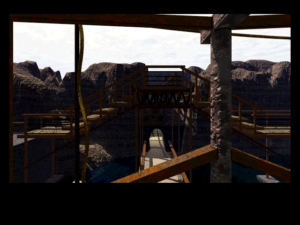Rhem
 When I said yesterday that I wanted something more thinky, what I was planning to do was pick up a copy of Myst V: End of Ages at one of the various retailers I pass on the way home from work. But it turns out that it’s no longer on store shelves (although, for some reason, Uru: The Path of the Shell is.) I have already made other arrangements to acquire it: as a completist, I definitely want to finish the Myst series sometime, even though the series seems to have peaked at Riven. But in the short term, I’ll have to make do with the next best thing: a blatant Myst imitation. Fortunately, I have several.
When I said yesterday that I wanted something more thinky, what I was planning to do was pick up a copy of Myst V: End of Ages at one of the various retailers I pass on the way home from work. But it turns out that it’s no longer on store shelves (although, for some reason, Uru: The Path of the Shell is.) I have already made other arrangements to acquire it: as a completist, I definitely want to finish the Myst series sometime, even though the series seems to have peaked at Riven. But in the short term, I’ll have to make do with the next best thing: a blatant Myst imitation. Fortunately, I have several.
Rhem is one of the better ones, and in some respects utilizes the form better than any of the actual Myst games. Andrew Plotkin’s review does a good job of explaining this. I honestly don’t know if I’ll have anything significant to add to what he says. I will note, however, that while his review talks at some length about three CDs and overcoming the need to swap disks, the game was later re-released on a single CD, apparently the result of better video compression. This is the edition I’m playing.
My history with Rhem is typical of my experience of graphic adentures. I started it, got a good way into it, got stuck, got distracted, and set it aside to finish later. Well, this is not a game that you can just abandon for a week and remember enough of to keep playing. Some time later, after some system upgrades, I tried to play it again, but hit strange technical problems. The publisher’s tech support was unable to help me, as is usually the case with games more than a year or two old. Whatever the problem was, subsequent upgrades seem to have fixed it. (I love it when that happens.) I have of course forgotten most of the game, but I have a vague recollection of what I did before that makes it a little easier to figure out what to do.
Faded familiarity does not, however, make the map easier to navigate. Talk about twisty passages — Rhem is made largely of catwalks and stairways that cross over and under each other a lot, ruining my sense of where I have and have not been already. The game provides a partial map at one point, and I’m relying on that a lot, when I can figure out where I am on it. Annotating the map with the locations of stairs helps a lot. I may wind up making a simpler map that only notes junctions, once I have a better handle on the layout. As much as the author has tried to ease navigation within the framework of a Macromedia Director adventure game, I really think this aspect of the game might be served better by a full 3D engine, where continuity of motion would make it easier to keep track of which peripheral objects are which. Or maybe not: it would slow down movement, now handled by swift mouse clicks. Besides, it’s not like the author had the time or the budget to develop such a thing. This is another of those indy efforts, sold at first exclusively through the author’s website, and I’m glad that he chose to devote his efforts towards a game rather than a new engine. But the point is, Rhem is conceived as a continuous three-dimensional object, and understanding how that object is put together is crucial to figuring out the game. I made comments to this effect about The Neverhood, but it’s even more true here.
 Comments(0)
Comments(0)